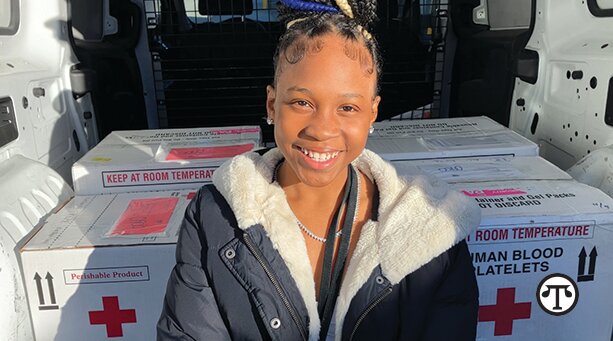 Post Classifieds
Post Classifieds
You Can Help People Living with Sickle Cell Disease

(NAPSI)—At 18 years old, Tymia Green has already accomplished remarkable feats. She’s graced fashion runways as a teen model, clinched the title of Miss South Carolina Pre-Teen, lobbied Congress on behalf of Medicaid on Capitol Hill, served as an ambassador for the Medical University of South Carolina Children’s Hospital, and recently graduated high school—all while courageously battling sickle cell disease.
“I love using my voice for the people who are not heard and showing the world what you can do, even with a disability,” said Green, who was diagnosed with sickle cell disease at three weeks old.
Complications of Sickle Cell Disease
The most common genetic blood disease in the U.S., sickle cell disease distorts soft, round blood cells and turns them hard and crescent-shaped, which can cause extreme pain and life-threatening complications—a harsh reality Green knows all too well.
At one years old, she suffered from splenic sequestration when her sickled red blood cells became trapped in her spleen, blocking blood flow and causing her spleen to swell.
“I was too small in size for my age to go through surgery, so I had to have a year’s worth of blood transfusions, once a month, until I turned two years old,” said Green.
The monthly red blood cell exchanges Green received as a toddler were a non-surgical therapy that removes abnormal red blood cells and replaces them with healthy ones from blood donors.
Later, Green developed avascular necrosis of her hip and knee. This affects up to 10% of patients living with sickle cell disease and occurs when bone tissue dies as a result of blocked blood flow to the bones.
In addition to secondary complications, there have been numerous times Green has been hospitalized due to sickle cell pain crises and dangerously low hemoglobin levels.
“I could barely move, walk or stand up straight,” said Green. “I would have to have a blood transfusion, sometimes even two, to increase my hemoglobin and allow me not to be so lethargic.”
And then there was the time when the blood supply was low, and the blood Green desperately needed was not on the hospital shelves.
“It was one of the most scariest times in my life because I thought that I would not make it,” said Green. “My hemoglobin dropped to 5.9 and the blood that I needed was not available.”
Once a compatible blood unit was found, it was immediately transported from another state to transfuse to Green 10 hours later.
What You Can Do
“When I receive a blood transfusion, it makes me feel rejuvenated and makes me feel as though I am back to myself,” said Green, who has received 130 blood transfusions to date. “Even though I may be in the hospital, I have a little piece of my life back.”
To reduce the risk of transfusion complications, blood transfused to patients with sickle cell disease must be closely matched. Since these patients are three times more likely to find a compatible blood match from blood donors who are Black or African American compared to donors who are not, blood donors of all races and ethnicities are needed to help ensure a diverse blood supply to support the blood transfusion needs of all patients.
For those on the fence about giving blood, Green shares, “Just giving a moment of your time can help save a life, near or far, and help them to be able to be themselves again.”
To help people living with sickle cell disease, schedule an appointment to give blood by visiting RedCrossBlood.org/OurBlood or calling 1-800-RED-CROSS (1-800-733-2767).
Editors Note: While this article is of interest at any time it’s particularly so on or around World Sickle Cell Day, June 19, 2024.
On the Net:North American Precis Syndicate, Inc.(NAPSI)
Get Top Stories Delivered Weekly
Discuss This Article
GET TOP STORIES DELIVERED WEEKLY
FOLLOW OUR NEWSPAPER
LATEST REDHAWK REVIEW NEWS
RECENT REDHAWK REVIEW CLASSIFIEDS
OUTSIDE THE LINES
- 1 in 5 Vehicles on the Road Has an Open Recall—Yours C...
- A Difficult Diagnosis Sparks Hope and Support for...
- Fall For Improved Vehicle Protection
- Six Ways To Save Money This Holiday Season
- BigFuture Resources Help Students Discover College,...
- Anheuser-Busch Celebrates American Growers on National...
- What You Should Know About Healthy Aging
- What We Don’t Know Can Hurt: New Survey Reveals K...
- Blood Donors Quietly Revolutionizing Sickle Cell Treatment
- What You Need To Know About Vaccines On World Polio Day...
FROM AROUND THE WEB
- Navigating “Gramnesia” This Holiday Season
- BookTrib’s Bites: Dive Into These Four Exciting Fall Reads
- Easy Monster Margarita is No Trick, All Treat
- Help Marine Toys for Tots Deliver Hope to Children in...
- 5 Tips to Pick the Right Dental Plan
- BookTrib’s Bites: Four Fascinating Fall Reads
- The U.S. Can Make the Most of AI in Robotics
- Have a Boo-tiful Halloween with Chilean Citrus
- 5 Ways to Transform Your Kitchen and Bath with the Look...
- Many American Women Feel Financial Stress



